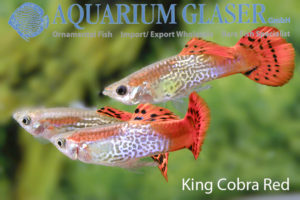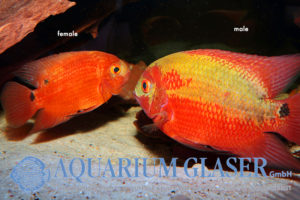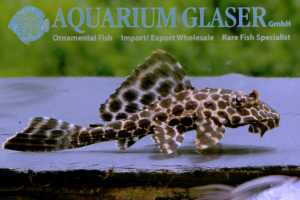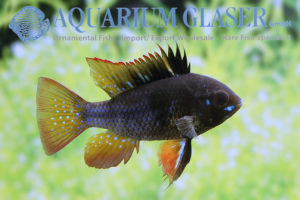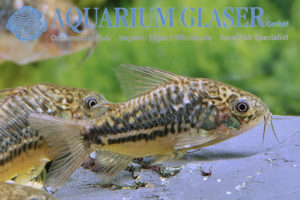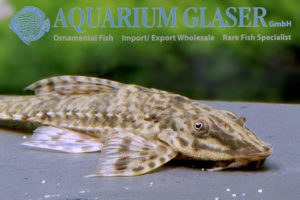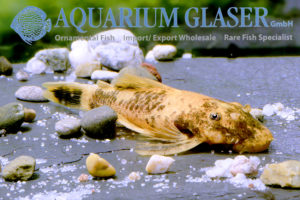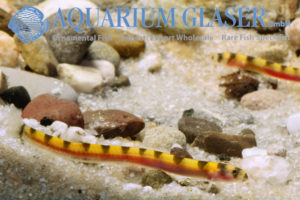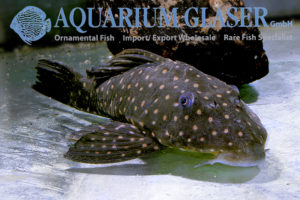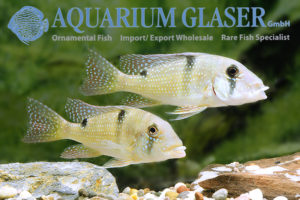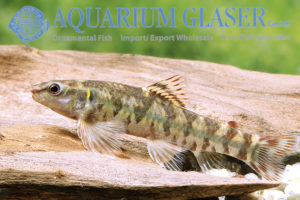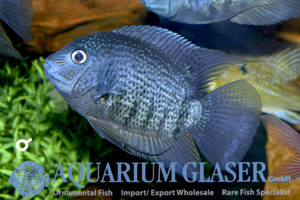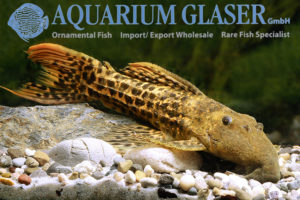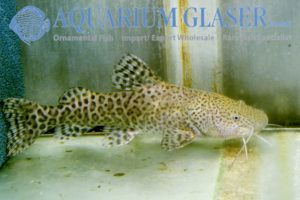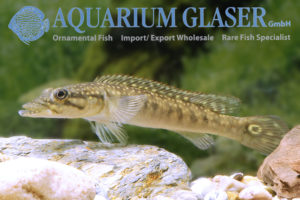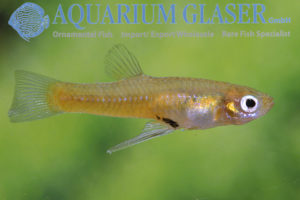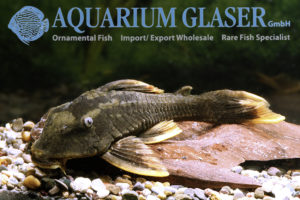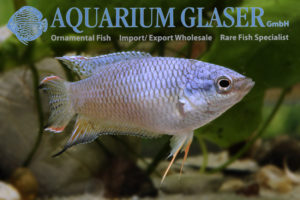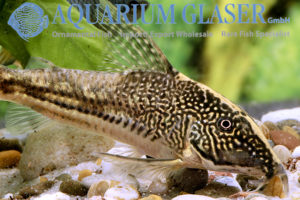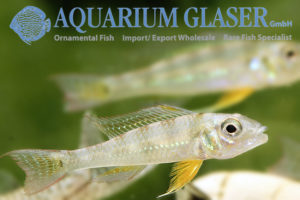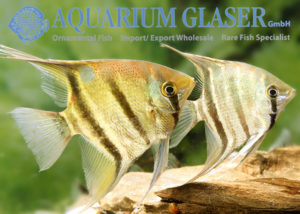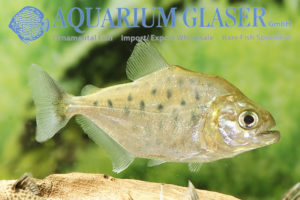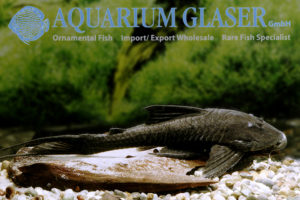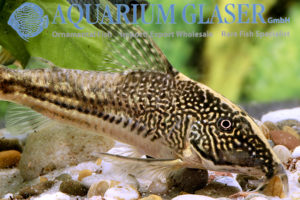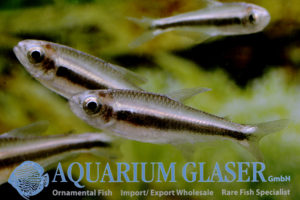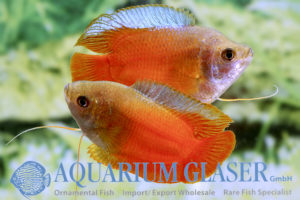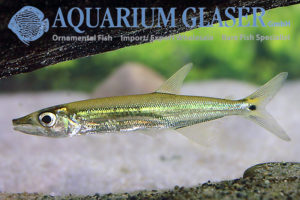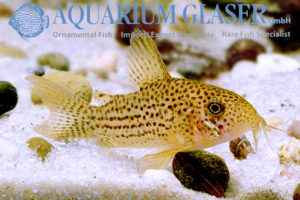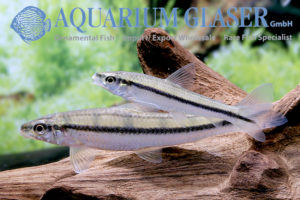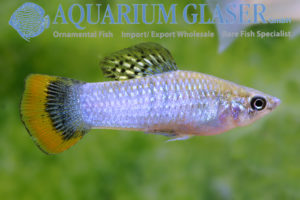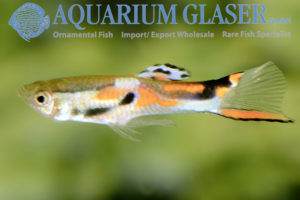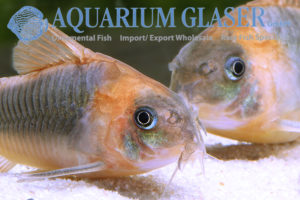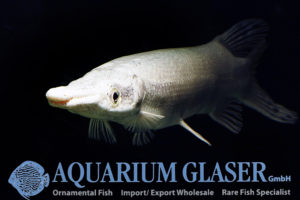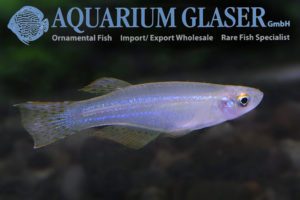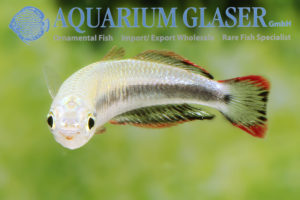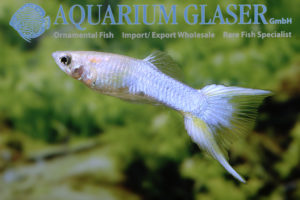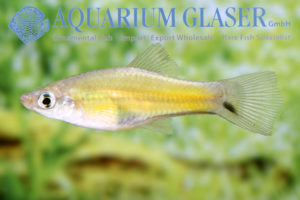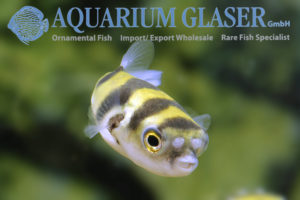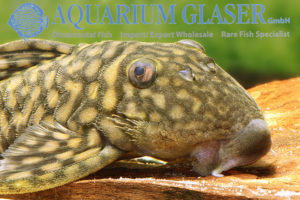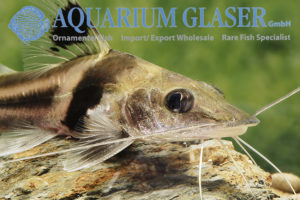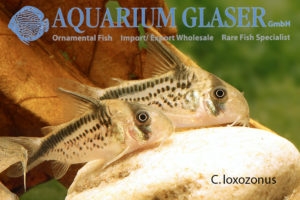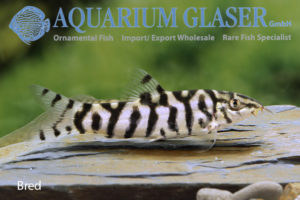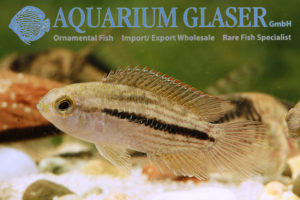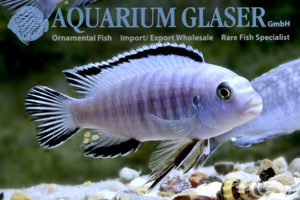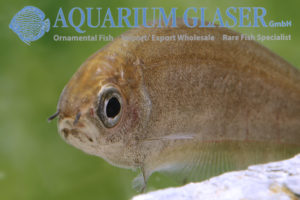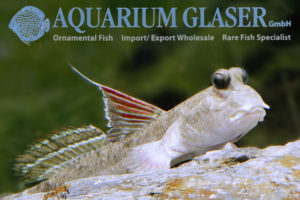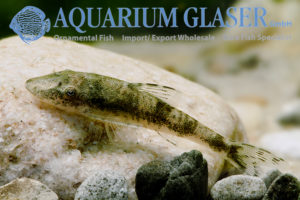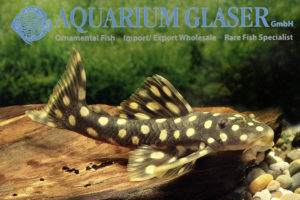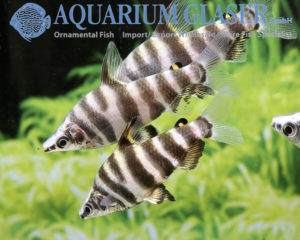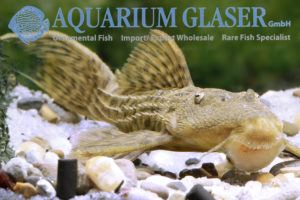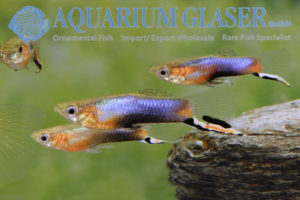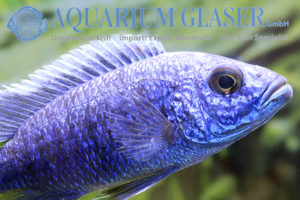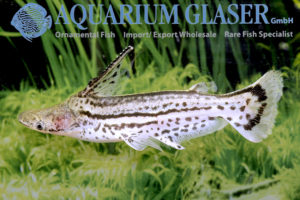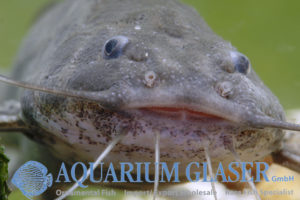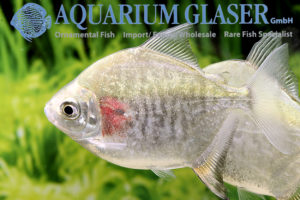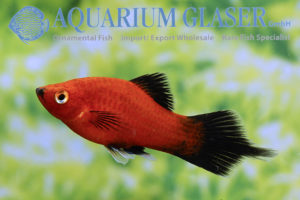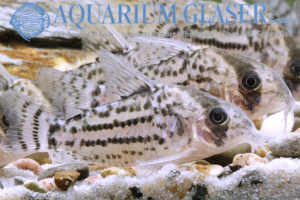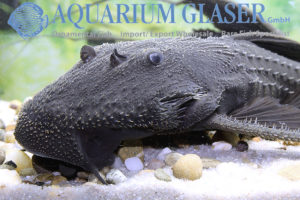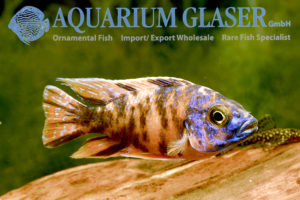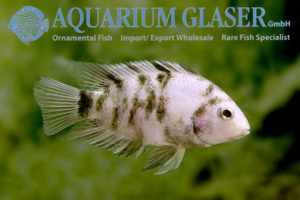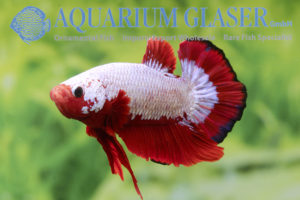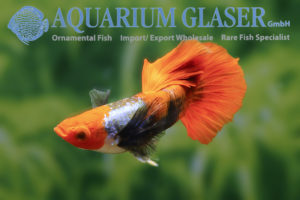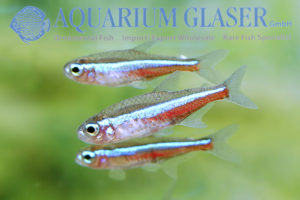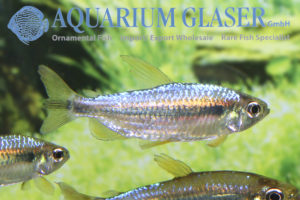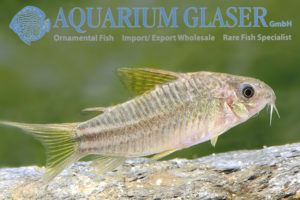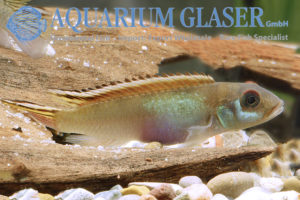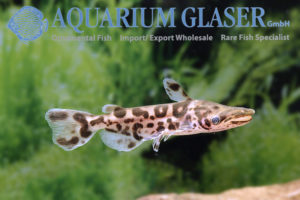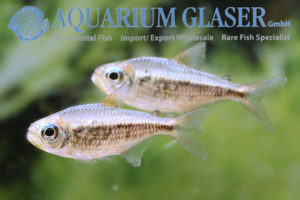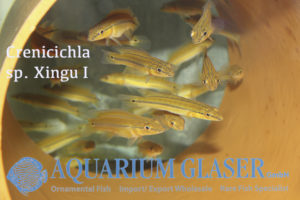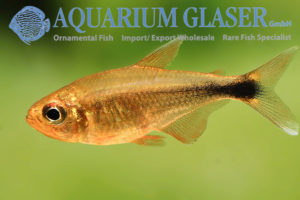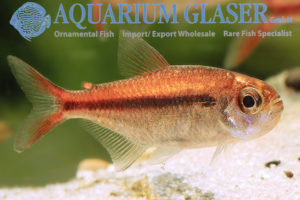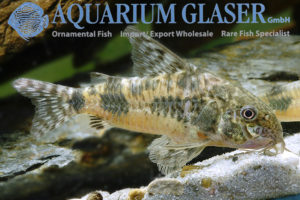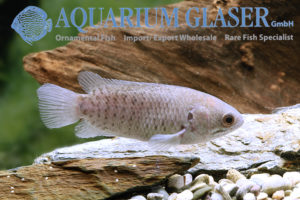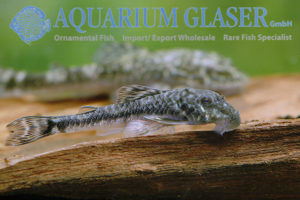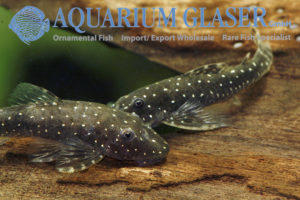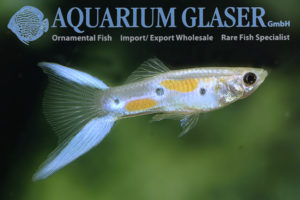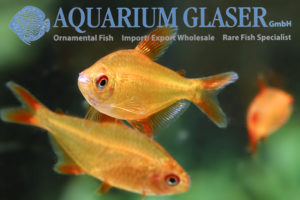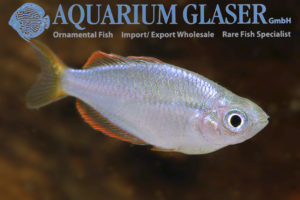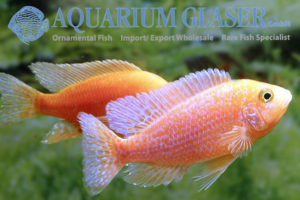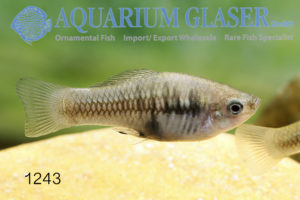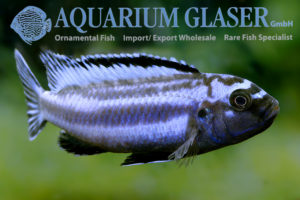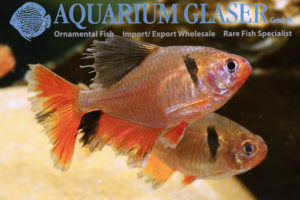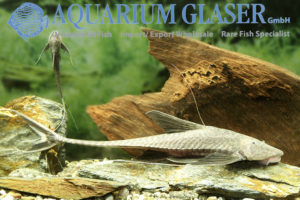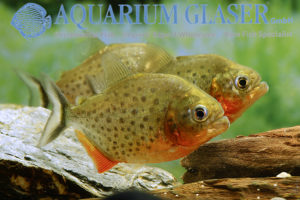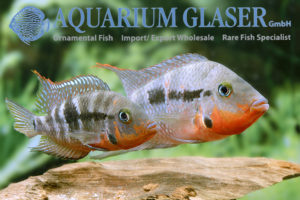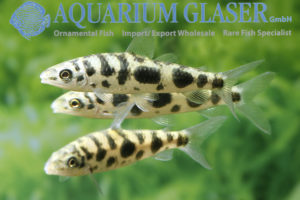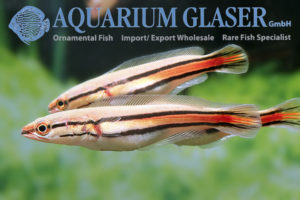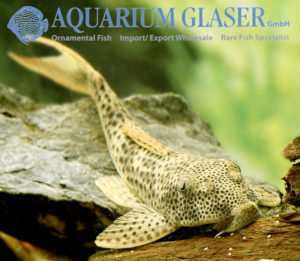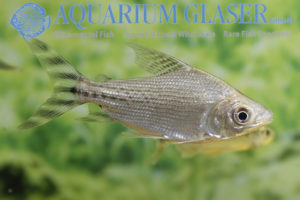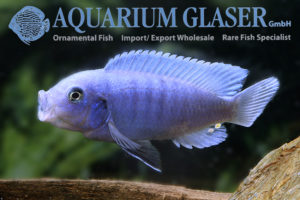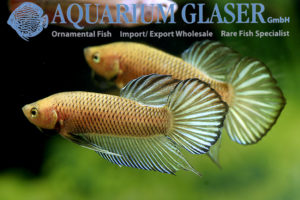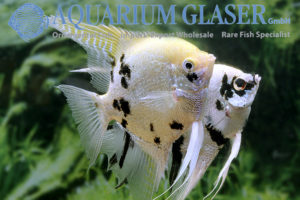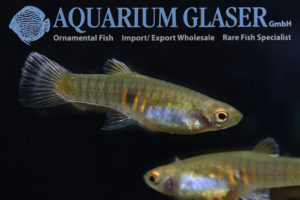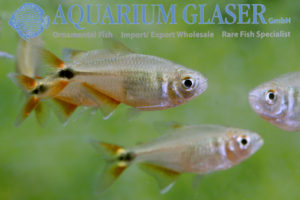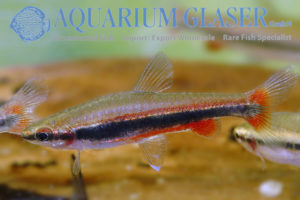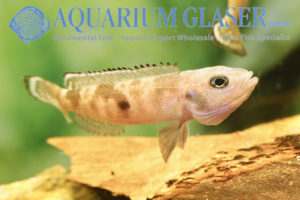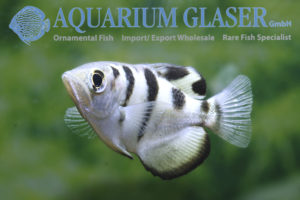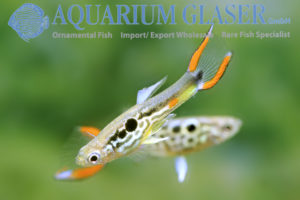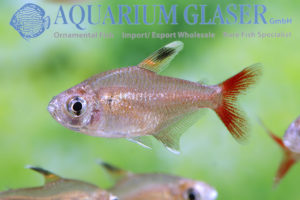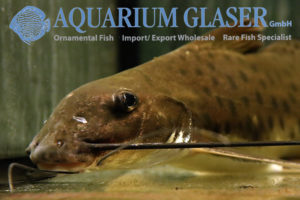The Filigran Guppys belong to the most popular Guppy forms. They have a body pattern of squiggles and dots, which is also called “Snakeskin” or King Cobra. This body pattern sometimes appears in wild Guppys, but it was not until the 1950s that it received more attention and was genetically characterized by M. Dzwillo in […]
Fish Archive (2963)
-
-
Hypselecara temporalis OYAPOC
The Emerald cichlid has become a bit out of fashion. This is a quite sad thing, for this impressive large cichlid – males can become up to 30 cm long, females always stay much smaller – is one of the most beautiful species of cichlid of South America. Once more we can offer now German […]
-
Glyptoperichthys gibbiceps
The red highfin sucker is a classic, which found its lovers long before the invention of the L-numbers. Juveniles are really adorable and excellent algae killers. In addition they look very beautiful. Since this catfish easily grows to 30-40 cm in length, there are two camps among aquarists. Some are critical of the animal because […]
-
Mikrogeophagus ramirezi “Black”
Black butterfly cichlids have been around for a few years and many breeders do an excellent job on them, so that really beautiful and healthy animals come on the market. We have now received a strain of Black Rams, in which the blue of the scales is limited to the rear half of the body […]
-
Corydoras undulatus Paraguay
The beautiful Corydoras undulatus belongs to the relationship of C. elegans. Like most representatives of this group the species swims rather in free water than on the ground. Also typical for the group is that males and females differ clearly in color. In the case of C. undulatus the males become very dark with bright […]
-
Rineloricaria parva
From Paraguay we regularly receive shipments of the small whiptail catfishes of the genus Rineloricaria. No less than 65 species are currently recognized, which makes identification in many cases almost impossible without knowledge of their origin. But in the case of Paraguay, there is a recent revision of the species known from this river system […]
-
Ancistrus Orange Brown “LDA16”
This extremely attractive Ancistrus is a breeding form. The actual LDA 16 is a wild form imported in 1994 from Brazil (Rio Puraqequara, a tributary of the Rio Guamá, which in turn is a tributary of the Rio Tocantins) and is uniformly purple-brown in color. We do not know if the orange-blotched Ancistrus descended from […]
-
Pangio cuneovirgata
Usually the different species of banded Coolie loaches (Pangio kuhlii, P. semicincta, P. myersi, P. shelfordi, P. alternans, P. cuneovirgata, P. malayana) are not distinguished in the trade because they are so variable in color and are often imported mixed. The sorting of Coolie loach is an activity you don’t want your worst enemy to […]
-
Hypostomus roseopunctatus L311
Not less than 148 species are counted to the genus Hypostomus, but no five of them appear more often in the trade. Special is of course H. luteus with its sail-like dorsal fin and the bright yellow coloration, but most species are “plecos”, brown or gray with black spots. In addition, most species grow quite […]
-
Geophagus harreri
In very small numbers we have received this beautiful Geophagus as German offspring. The species reaches a maximum length of 20-25 cm and is exclusively found in the inlet of the Marowijne River, the border river between French Guyana and Suriname. One of the tributaries of the Marowijne is the Maroni River, known to cichlid […]
-
Characidium fasciatum (C. cf. pterostictum, P. sp. V)
The South American darters of the genus Characidium are unfortunately almost indeterminable. There is no current revision of the 95 described species, but additional species are constantly being described and it is known that there are still numerous scientifically unrecorded species. In aquaristics one therefore helps oneself by simply calling everything “Characidium fasciatum”, well knowing […]
-
Heros sp. Madeira
The Rio Madeira is a right tributary of the Amazon River and is considered the largest tributary in the world. Its origin is in Bolivia where it is formed from the confluence of the Rio Beni and the Rio Marmoré. It flows into the Amazon in Brazil at Itacoatiara. The Rio Madeira is a white […]
-
Pseudacanthicus sp. L273 Titanic
The magnificent cactus catfish L273 Titanic, up to 30 cm long, originates from the Rio Tapajós. Its first import in 1998 was a sensation. Interesting about the animals, which are allowed to be exported from Brazil again since some time, is the very individual body pattern. All cactus catfishes are carnivores; towards non-species fishes they […]
-
Zungaro zungaro
The catfish Zungaro zungaro belongs to the largest catfish species of South America. There were all kinds of debates about its name, for a long time it sailed under Pseudopimelodus zungaro or Paulicea luetkeni. Because of its gigantic size (length up to 140 cm, weight up to 50 kg) the species is difficult to study […]
-
Crenicichla jegui
The pike cichlids (Crenicichla) are with 94 accepted species (and there are still a large number of undescribed ones) the most species-rich genus of cichlids at all. One of the most distinctly different species is Crenicichla jegui from the Rio Tocantins drainage. There the fish lives very hidden and was therefore discovered only when the […]
-
Girardinus uninotatus
From the currently seven accepted species of the genus Giradinus only G. metallicus and occasionally G. falcatus are offered in the trade. We have now received a small number of G. uninotatus from a breeder. They are really no color miracle, but their pretty apricot color is quite interesting. The species oirginates from Cuba. The […]
-
Cochliodon sp. L360
We have received some beautifully marked yellowseam catfish. This catfish originates from the middle Rio Jamanxin in Brazil and has not yet been correctly (i.e. scientifically) identified, neither in terms of genus nor in terms of species. However, it is quite possible that this catfish has already been scientifically described; young animals are quite inconspicuous, […]
-
Macropodus spechti “Royal Blue”
For the first time we can offer this magnificent breeding form of the black paradise fish. Our breeder writes about it: How did I become aware of these fish: In 2019, I saw a picture of blue paradise fish from Vietnam in a Facebook group for paradise fish lovers by chance. Being skeptical at first […]
-
Scleromystax barbatus
The changed legal situation in Brazil now makes the import of several species from the south of Brazil possible again, which for many years were only available as offspring, among them the magnificent Scleromystax barbatus (formerly Corydoras b.). We have been able to import a good number of wonderful, fully grown specimens. For more information […]
-
Biotoecus dicentrarchus
The dwarf cichlids of the genus Biotoecus were shrouded in mystery for decades. The first species, B. opercularis, was scientifically described as early as 1875. It originated from the Amazon River basin in Brazil, a well-collected area for aquaristic purposes, and yet the first import was not accomplished until the mid-1980s and early 1990s. The […]
-
Pterophyllum leopoldi (“dumerilii”)
This season we received especially attractive Pterophyllum leopoldi from Brazil. Unfortunately, the animals do not like the photo tank at all and show there only a fraction of the wonderful colors – a magnificent green shimmer all over the body and a very nice red tone in the back – that well acclimated animals of […]
-
Serrasalmus cf. gouldingi
It is indicative of the difficulties in piranha identification that this widespread species, which also occurs in an area intensively collected for the aquarium hobby (namely, the Rio Negro) was not scientifically described until 1992 and, moreover, almost never appears in the hobby. The terra typica is Anavilhanas, Río Negro, Brazil. The representatives of this […]
-
L350 Panaque sp. Black Lyretail
From Peru we received four specimens of a top rarity: L350. This peculiar fish does not fit any genus of loricariid catfish known to date. It originates from deep, turbid, very fast flowing water of the Peruvian Amazon, where it can only be caught with great difficulty and rarely. It is a carnivorous species whose […]
-
Scleromystax barbatus
The changed legal situation in Brazil now makes the import of several species from the south of Brazil possible again, which for many years were only available as offspring, among them the magnificent Scleromystax barbatus (formerly Corydoras b.). We have been able to import a good number of wonderful, fully grown specimens. For more information […]
-
Moenkhausia phaeonota
This small (about 4 cm) species of tetra originates from upper Rio Tapajós basin the Mato Grosso state in Brazil. It is the only species of Moenkhausia with such a colour pattern. So already in the original scientific description (1979) the author mentioned that this generic placement can be only provisionally. This makeshift stands until […]
-
Colisa lalia “Flame Red
Only from few breeding forms is so well known, when they originated, as with Colisa lalia “Flame Red”. At the same time the fish decorated the covers of all aquaristic journals worldwide in the early 1980s, so sensational were they found. The animals were bred in the Lim Choa Kang area of Singapore, a rural […]
-
Acestrorhynchus cf. minimus
Unfortunately, almost all predatory fishes have one unpleasant characteristic: most of them grow too large for average aquarium dimensions. In many cases we can only keep juveniles for some time and have to part with them when it becomes nice. What a pity! An exception to this rule is Acestrorhynchus minimus, a barracuda tetra from […]
-
Corydoras eversi (C65)
The very nice Corydoras eversi lives in the Araguaia drainage (Brazil) and became known as C 65. It was only scientifically described in 2016. The scientific treatment of C. eversi is based on a collection by Hans-Georg Evers in 1998, who was also able to bring living animals with him. As mentioned, they were initially […]
-
Apareiodon affinis
Now begins the season for one of the best algae eaters of all, the La Plata algae eater from Paraguay. Originally the species was described as Parodon affinis. It is amazingly similar in shape and coloration to the Asian Flying Foxes; but of course, the La Plata algae eater can always be easily recognized by […]
-
Poecilia mexicana “Campeche”
The wild mollies are – from a zoological-systematic point of view – certainly one of the most difficult fish groups at all. Not without reason, science has been wavering between two extreme views for over 100 years: the first states that all wild mollies belong to only one, highly variable species, which would then be […]
-
Guppy Endler
No fish species is as changeable as the Guppy. There are no two males in nature that are exactly alike in color. This is true for all four Guppy species (Poecilia reticilata, P. wingei, P. obscura and P. kempkesi), which therefore cannot really be distinguished from each other externally (genetically, however, they can). In the […]
-
Coryoras eques
From the Brazilian state of Amazonas, more precisely from the surroundings of the city of Anori, we once again received a good number of a beautiful armored catfish, which is known to science for a long time, but rarely appears aquaristically: Corydoras eques. This typical schooling Corydoras looks most attractive when kept in black water. […]
-
Atractosteus spatula
The Alligator gars are so-called living fossils. They developed about 100 million years ago in the upper Cretaceous and haven´t changed much since then. Currently two genera live in the New World, namely Atractosteus (containing three species) and Lepisosteus (four species). The members of Atractosteus can reach about 2 m in length (formerly they are […]
-
Procatopus aberrans
Again we could import the lampeye fish Procatopus aberrans from NIgeria; unfortunately we do not know the location where they were collected. However, we know that our supplier occasionally receives fish from Cameroon. Anyway, the current imports are a bit more graceful in body structure and the upper half of the iris lacks the red […]
-
Bedotia geayi
This is the only almost always available aquarium fish that comes from the large, geologically old island of Madagascar. All other freshwater fishes from this island, which unfortunately are often threatened with extinction due to massive environmental changes, are only suitable for specialists. The beautiful Madagascar rainbow (Bedotia geayi) grows to a length of 10-12 […]
-
Guppy Japan Blue and Japan Red
There is a number of tail fin shapes of the guppy, which have been standardized by the guppy breeders. As a rule, however, these breeds are only found at private breeders. In the pet trade the triangle guppies dominate in such a way that aquarists, who do not inform themselves specifically about guppies, could get […]
-
Xiphophorus signum
This species of swordtail is only very rarely offered in the trade. At the first glimpse one may think that they are a variety of the common swortail X. hellerii, but the species X. signum is much more slender. The mark that is responsible for the scientific name (latin signum = sign) is always good […]
-
Colomesus asellus
The South American puffer fish Colomesus asellus are ideal for aquarium care. They remain small (usually around 6-8 cm, at most around 12 cm, other sizes given in the literature are based on confusion), are pure freshwater inhabitants, love to eat small snails and are absolutely peaceful, both against conspecifics and against other fish species. […]
-
Spectracanthicus (= Oligancistrus) zuanoni L 354
Spectracanthicus zuanoni L 354 originates from Rio Xingu and the Rio Iriri in Brazil. It has been described scientifically only in 2014 (see http://www.aquariumglaser.de/en/archiv.php?news_id=1195). The fish belongs to the same species as L 20, with however clearly larger white marks, so that the design reminds of a black net on a bright background. The reddish, […]
-
Pimelodus ornatus
One of the most attractive large catfishes is Pimelodus ornatus, which is common in large parts of tropical South America. It is reported from the big rivers Amazonas, Orinoco and Parnaná, in addition the Guyana states. Maximum size reported is 38.5 cm (excluding caudal fin). The beautiful and lively fish is notorious for its venomous […]
-
Corydoras loxozonus and C. sp. aff. C16
Corydoras loxozonus belongs to the beautiful armored catfishes, which we receive relatively regularly from Colombia. The species is quite variable in pattern and therefore has already received the C-numbers C79 and C83. There was never any “proof” that these C-numbers really belong to the species C. loxozonus; this was only concluded from the fact that […]
-
Botia lohachata
The systematics of the Indian deep bodied loaches – they represent the remaining species in the formerly much broader genus Botia – is confused. Botia lohachata was described from Bihar in India as early as 1912. Their coloration is very specific: three Y-shaped bands – the first in front, the second below and the third […]
-
Nannacara taenia
Nannacara taenia is with a maximum of 5 cm total length one of the smallest cichlids at all. Additionally it is absolutely peaceful and therefore an ideal fish for community aquariums. The species was described in 1911 from aquarium fishes believed to have been exported via Manaus. However, these animals were never found again in […]
-
Chindongo socolofi (= Pseudotropheus s.)
What is the saying? Who does not ask, remains stupid. In the case of the rock cichlids of Lake Malawi, the so-called Mbuna, it is undoubtedly the garish, bright colors that initially attract attention and led to the much quoted comparison with coral fish. In fact, the colors of the mbuna have primarily the same […]
-
Xenomystus nigri
Knifefishes are found in the Old World (Africa, Asia) and in the New World (South and Central America). However, the two groups are not closely related. Aquaristically, however, they are quite comparable. They inspire above all by their elegant swimming. The very special fin structure allows them to maneuver both forward and backward. At the […]
-
Periophthalmus novemradiatus
The Indian Dwarf Mudskipper, Periophthalmus novemradiatus, is the ideal aquarium mudskipper with its usually 6 cm length (in literature up to 10 cm are given, but we have never seen such large specimens, probably this statement is based on confusion with other species). In addition to its small size, it has many other favorable attributes: […]
-
Curculionichthys sabaji
A very long name for a very small fish! The genus Curculionichthys was established only in 2015 to accommodate dwarf sucker catfishes of the subfamily Hypoptopomatinae (formerly: Otothyrinae) of Loricariidae, which were previously placed in the genus Hisonotus. Both anatomical and molecular data showed that two independent evolutionary lineages existed within Hisonotus, namely that around […]
-
Ancistrini sp. L82
Among the species threatened by the construction of the Bela Monte Dam is L82, a species of loricariid up to about 15 cm long, which cannot yet be assigned to any genus described scientifically to date; it is most similar to Scobinancistrus. Also on species level L82 is not yet worked on. The only certainty […]
-
Abramites hypselonotus
The marbled headstander is perhaps the most unusual of all headstanders. This beautiful fish grows to about 15-20 cm in length and is hard to mistake because of its high body shape. There is only a second Abramites species, A. eques, but it has never been imported alive. It lives exclusively in the Rio Magdalena […]
-
Pseudacanthicus sp. L79
This very flat Pseudacanthicus from the Rio Tocantins belongs to the rarest L-catfishes on the market. Even before the export ban by the Brazilian authority IBAMA, which was lifted only recently, the fish came to us only very sporadically. L79 certainly grows over 20 cm long, but exactly how big is unknown. Our animals are […]
-
Poecilia wingei Blue Star
Poecilia wingei is widely distributed in the hobby after its best known local variant as Endler´s Guppy. It remains much smaller than the normal Guppy and is very popular with many aquarists because of its graceful body shape. Just as with the common Guppy, numerous local forms can be observed with P. wingei. The ancestor […]
-
Sciaenochromis fryeri
Many rock dwelling cichlids (mbunas) of Lake Malawi live isolated on certain rocky shores. These are often miles away from other rocky biotopes, so geographic isolation leads relatively quickly to local color variations. Other cichlids of the lake, such as Sciaenchromis fryeri, are not bound to specific biotopes and occur accordingly throughout the lake. Although […]
-
Ageneiosus magoi
Males of all dolphin catfishes (Ageneiosus) develop huge dorsal fin spines and a penis-like mating organ at spawning time, also strange tooth-like looking papillae on the posterior margin of the upper jaw. They use the dorsal fin spine to clamp females for mating, and fertilization occurs internally. After spawning, the dorsal fin spine is shed […]
-
Wertheimeria maculata
Wertheimeria maculata belongs to the strangest thorny catfishes. You don’t see this on the relatively inconspicuous juveniles with their 6-8 cm length, but it is nevertheless so. The first thing that catches your attention is the really high price that is demanded for them. This is due to the fact that these fish are local […]
-
Mylesinus paucisquamatus
A few weeks ago we introduced you to a new pacu, which we received as Tometes kranponhah. At that time we thought the animals originated from the Rio Xingu. (see https://www.aquariumglaser.de/en/fish-archives/tometes-kranponhah-2/) In the meantime, further correspondence with our supplier revealed that the animals did indeed come from the Rio Tocantins. We have received another shipment […]
-
Platy Wagtail Pointed Tail
The “pointed tail” mutation, in which the middle caudal fin rays are elongated, appeared relatively late: the first specimens appeared on the market in the 1980s. It originated in the Southeast Asian large-scale breederies. The characteristic, which first appeared in the Platy (Xiphophorus maculatus), can also be transferred to other Xiphos, but the pointed tail […]
-
Corydoras schwartzi
This well known, but still beautiful Corydoras originates from the Rio Purus system in Brazil. It was named in honor of the exporter Willy Schwartz. In Corydoras schwartzi, which belongs to the stocky, round-headed members of the genus, the dorsal fin is marked very slightly differently in each animal, the coloration of the spine ranges […]
-
Acanthicus sp. L155 Furo Maguari
Acanthicus hystrix is one of the great myths in the literal sense. With a length of almost one meter it is one of the largest loricariid catfishes at all. In addition, the species, which was already described in 1829, is extremely prickly: “hystrix” means “porcupine”! Unfortunately, the specimen on which the description of this species […]
-
Aulonocara Orange Blotched
Everything there is to say about these wonderfully colorful cichlids has already been said about another breeding variety, the Aulonocara Dragon Blood: https://www.aquariumglaser.de/en/fish-archives/aulonocara-dragon-blood-2/ The Orange Blotched are now one of the most common Malawi cichlids on the market. No wonder: there is hardly a fish species, which shows such a variety of bright colors, like […]
-
Amatitlania (formerly Cichlasoma) nigrofasciata Marble
The convict cichlid Amatitlania (formerly Cichlasoma) nigrofasciata is really not a novelty anymore: it has been kept and bred in aquariums since 1939. The first aquarium animals of this very widely distributed fish in Central America came from the lakes Atitlan and Amatitlan in Guatemala. The genus to which the convict cichlid currently belongs was […]
-
Betta splendens Hellboy II
Some time ago we introduced a short-finned fighting fish breeding form (“Pla Kat”) of Betta splendens as “Hellboy”. (https://www.aquariumglaser.de/en/fish-archives/betta-splendens-pla-kat-hellboy-and-giant-halfmoon/). Now we have received Pla Kat under this name from Thailand again, but they differ from the first Hellboys in color and fins. The new Hellboys have a halfmoon tail fin, which means that when the […]
-
Guppy Kohaku Koi Tuxedo
Guppy breeders are currently very active again and bring new, attractive strains on the market. The Guppy Kohaku Koi Tuxedo combines two special characteristics: The Kohaku factor, which causes males and females to have a red head combined with a red caudal fin and red dorsum; and the Elephant Ear factor, which causes the greatly […]
-
Paracheirodon simulans
Paracheirodon simulans is the smallest and tiniest species of neon tetra. The maximum length is around 2.5 cm. One should not confuse this species with the neon costello, Hemigrammus hyanuary, which is also called the “green neon” occasionally. This is the reason why some people call Paracheirodon simulans the “blue neon”, but in the international […]
-
Alestopetersius leopoldianus
Our current Congo import contained among others the magnificent tetra Alestopetersius leopoldianus, which originates from Lac Mai Ndombe (formerly: Lake Leopold) and the middle Congo. With this maximum 9 cm long species one can get philosophical about the supposed objectivity of photography. Depending on the incidence of light the animal looks completely different! With the […]
-
Corydoras elegans C123
The beautiful Corydoras elegans is widely distributed in the Amazon region and locally forms numerous color forms. Possibly all these variants are even independent species, but scientifically this has not been investigated yet. A color variant from the Rio Nanay in Peru stands out above all by yellow-orange tinted fins. Some males (they have higher […]
-
Nanochromis parilus wild
Since a long time we received again a Congo import. Beside many other interesting fishes and novelties also the good old acquaintance Nanochromis parilus was among them. These beautiful, assertive dwarf cichlids are very common in the region around the capital Kinshasa. It is astonishing that they were described by science only in 1976. In […]
-
Ageneiosus inermis
Already in 1766 this catfish was described by Linné. It is one of the most widespread species in South America. It has been reported from Argentina, Bolivia, Brazil, Paraguay, Ecuador, Peru, French Guiana, Guyana, Suriname, Uruguay, Colombia and Venezuela. In the course of the centuries many synonyms accumulated: 12 times this species was described under […]
-
Moenkhausia nigromarginata
Again we can announce a first import: Moenkhausia nigromarginata. For the first time ever we received some of these tetras described in 1994. The species reaches a length of about 5 cm. Striking are the blue eye, the blue back in incident light and the – sometimes more and sometimes less visible – zigzag bands […]
-
Crenicichla from the Rio Xingu
In the 1990s, when the large river cichlids of Brazil experienced a certain boom, also four Crenicichla species came to Europe for the first time, which were named Crenicichla sp. Xingu I – IV due to the lack of availability of a scientific name. All four grow quite large by ornamental fish standards, you have […]
-
Hyphessobrycon moniliger
Under the name “Hasemania hansseni” a new tetra has recently appeared on the market, which with its intense orange coloration is indeed somewhat reminiscent of the well-known copper tetra, Hasemania nana. However, one of the characteristics of the genus Hasemania is that it lacks the adipose fin that is so typical for tetras. This is […]
-
Moenkhausia rubra
New legislation in Brazil now allows the import of species whose export was previously not allowed. One of these species is Moenkhausia rubra, which was only scientifically described in 2014. The species is so far known only from the Rio Juína and the Rio Juruena, both belonging to the upper Rio Tapajós drainage, Mato Grosso […]
-
Coyrdoras paleatus wild
Only very rarely we receive wild collected Corydoras paleatus. Imports of this species, which is widespread in southern South America, didn´t appear for more than 10 years, because many export stations in southern Brazil had to close down when some of the most important ornamental fishes of the region were forgotten on the Brazilian positive […]
-
Anabas testudineus
There are many criteria, why to choose this or that fish for the aquarium. Those who like colorful fish should avoid Anabas. But who likes to observe biological peculiarities is well advised with the climbing perch. General information about Anabas can be found here: https://www.aquariumglaser.de/fischarchiv/anabas_de/. We have now once again imported climbing perch from Bengal. […]
-
LDA25 Parotocinclus jumbo
The Pitbull Pleco (Parotocinclus jumbo, formerly Hypostominae gen. sp.) was one of the most popular small sucking catfishes until about 10 years ago. Then it was accidentally forgotten on the list of Brazilian ornamental fishes allowed for export. Since then, it has only been around in breeder circles. This species, very common in the wild, […]
-
Parotocinclus haroldoi
Perhaps the prettiest and at the same time most suitable otocinclus for aquaristics is Parotocinclus haroldoi. Concerning the coloring – yellow-white, shining spots on black underground – the species resembles the adonis pleco (Acanthicus adonis), remains however with maximally 4 cm (male) and at all-highest 5 cm (female) much, much smaller. Until now this species, […]
-
Guppy Neon Green Lyretail
Aquaristics is unimaginable without the multitude of colorful livebearer breeding forms. However, this also means that there is competition between the different breeding lines for the buyers’ favor. A good name clearly sells. And even if, strictly speaking, the Neon Green Lyretail is neither neon green in color nor has a lyre tail – who […]
-
Hyphessobrycon sp. “Muzel Red Cherry“
From Brazil we received this really nice novelty, which looks a bit like an enlarged edition of the Ember tetra, Hyphessobrycon amandae. However has the “Muzel Red Cherry” two (although indistinct) shoulder spots, which never occurs in H. amandae. In addition, the dorsal fin in “Muzel Red Cherry” is red with a light margin, while […]
-
Melanotaenia praecox
The Diamond Rainbowfish – Melanotaenia praecox – is one of the smallest species of the actual rainbowfishes and grows only 6-7 cm long. It shows already from 3 cm length its splendid iridescent body coloration. That is why it is one of the most popular species in the trade. With age the males become high-backed […]
-
Aulonocara “Dragon Blood”
Aulonocara are a specious and colorful genus of Malawi cichlids; because of their brightly colored dress they are called “peacocks” in English. They are small-animal eaters that selectively ingest small chunks of food. Another group of cichlids in Lake Malawi feeds on the algae and the microorganisms (= Aufwuchs) they contain, which grow on rocks. […]
-
Xiphophorius variatus “Hotel Taninul” and “Code 1243”
We have already introduced several wild strains of Xiphophorus variatus, which rightly bears its scientific species name (variatus = variable). Now we have again two new variants on offer, both are German bred ones, descended from wild populations. The first is a pretty speckled fish discovered and brought back on a scientific collecting trip in […]
-
Melanochromis johannii
The bluegray mbuna or the electric blue johanni (Melanochromis johannii) was imported so early (1972) from Lake Malawi for the hobby that one still made the effort to invent a popular name for it. This was later abandoned in view of the great number of species. In the wild, these fish, like many other Aufwuchs-feeding […]
-
Hyphessobrycon eques “Longfin”
The Serpa Tetra, also called the Callistus Tetra (Hyphessobrycon eques, formerly known as H. callistus or H. serpae), is the little man’s piranha. Just like piranhas, serpa tetras have an irresistible urge to bite the fins of other fish. And they constantly want to test out who is the stronger. This makes many exciting observations […]
-
Pterosturisoma microps
This interesting, about 20-25 cm long sucking catfish from Peru should only be kept by really experienced aquarists. Beside some adult specimens we could import this time also 4-7 cm long juveniles. The size of these fish is difficult to state, because one should not count the tail fin filaments, which are much longer than […]
-
Pygocentrus nattereri
The red-breasted shoaling piranha (Pygocentrus nattereri) is present throughout the Amazon River basin. It is the most common piranha species kept in aquariums. The breeding of these animals succeeds according to plan. Pairs are formed from a shoal, which spawn in bottom pits; the parents guard the spawning site, there is no brood care beyond […]
-
Thorichthys meeki “Rio Candelaria”
The Rio Candelaria is a lowland river in Central America. It originates in northern Guatemala and flows through regions there and in southeastern Mexico whose jungle landscapes were almost untouched by man for a long time. The Rio Candelaria gained sad fame because the conquistador Hernán Cortez had the last Aztec ruler Cuautémoc, a fierce […]
-
Leporinus ortomaculatus
For the first time we can offer this pretty Leporinus, which was scientifically described only in 2000. Be careful not to confuse it with L. octomaculatus, because this is a completely different species; here the confusion of one letter has consequences! So far Leporinus ortomaculatus is known from the Rio Surumu, Roraima, Brazil and from […]
-
Channa micropeltes
One of the most beautiful freshwater fishes of all is Channa micropeltes. This snakehead lives in groups and its favorite pastime is eating. It is therefore constantly on the lookout for food and swims lively in a shoal through the aquarium. Although every word up to this point is true, it is still only half […]
-
Aphanotorulus sp. L11
The correct name of this beautiful catfish from the Rio Xingu is a matter of dispute among experts. In many parts of South America similar looking catfishes can be found, which are all close to the species already described in 1840 as Hypostomus emarginatus. These were assigned to the genus Squaliforma in 2001, and to […]
-
Which Semaprochilodus comes from Indonesia?
Quite clearly – none at all! Because this genus is exclusively from South America. But in Indonesia these beautiful large tetras are bred and occasionally we import juveniles from there. Then one wonders which species it is. We get them as S. insignis and so we sell them on, but is the determination correct? This […]
-
Bright blue Maylandia from Thailand
The zebra cichlids of Lake Malawi were among the first cichlids to come to us from this great lake in the 1960s. At that time they caused real enthusiasm storms. Aquarists had no idea of the enormous diversity of species and forms that exist there. So the zebras were simply called “Pseudotropheus zebra” after one […]
-
Betta splendens Pla kat Yellow cheek Spadetail
The first documented domesticated form of the Siamese fighting fish (Betta splendens) was a Spadetail. That was in 1849. At that time certainly fighting fishes were bred for a long time, but they resembled more or less the wild fishes and were selected only for their fighting characteristics. The appearance of these animals was a […]
-
Angelfish XL
Fully grown angelfish of the various breeding forms are comparatively rare in the trade. The reasons are obvious: The breeding is time and space consuming, because they are still cichlids, which demand a certain individual space for themselves. That’s why XL angels have to be comparatively expensive. But occasionally such animals are in demand and […]
-
Neoheterandria elegans
Finally we have the dwarfish Neoheterandria elegans in our stock again. They originate from German breeding. These are among the smallest livebearing toothcarps regularly kept in the aquarium. Males grow to about 1-2 cm long, females up to 3 cm, but usually around 2 cm. The Teddy Livebearer, as it is called to distinguish it […]
-
Psalidodon anisitsi (= Hyphessobrycon a., Hemigrammus caudovittatus)
One of the oldest aquarium fishes is the Buenos Aires tetra, of which the correct scientific name was only recently determined: Psalidodon anisitsi. To most aquarists, however, the species is probably still known as Hemigrammus caudovittatus (or Hyphessobrycon anisitsi), and it is under this name that it is found in most aquarium books. Since its […]
-
Nannostomus beckfordi
Nannostomus, also known as pencil fish, propel through the aquarium like small, colorful zeppelins. The unusual, somewhat stiff-looking swimming style makes them unique in the colorful world of tetras. There are quite a few species of Nannostomus-species, but the Red Pencilfish (Nannostomus beckfordi), which grows up to 6.5 cm long (but appears smaller due to […]
-
Lepidiolamprologus attenuatus
The species of the genus Lepidiolamprologus belong with about 15 cm final length to the largest representatives of the Lamprologus relationship in Lake Tanganyika. They are predatory animals that like to feed on small fish. Like so many predators, they are remarkably peaceful toward fish that do not serve as food. In the lake, Lepidiolamprologus […]
-
Toxotes mekongensis
Archerfishes can be divided into two groups: those that live in the brackish water of estuaries, reproduce there as well (all archerfishes are free spawners without brood care) and can also live in pure seawater. These species are therefore widely distributed along the coasts of the Indo-Pacific from India to Japan and Australia. And then […]
-
Poecilia wingei Endler Campona No48 black green snakeskin
If there is one fashionable fish that has defined the last decade, it is the Endler guppy, Poecilia wingei. This small guppy species has countless fans all over the world and efforts are made to preserve the “pure” strains of wild caught variants. However, in the wild these wild variants are by no means uniformly […]
-
Hyphessobrycon micropterus
In 1915 the scientist Carl Eigenmann described a new tetra genus, which he named Megalamphodus. Type species is M. megalopterus, an aquaristic very well known species: the Black Phantom Tetra. In 1997 Megalamphodus became a synonym of Hyphessobrycon. Of the remaining species assigned to Megalamphodus in 1915 (ecuadoriensis, eques, heteresthes, melanotus, micropterus), only the Serpae […]
-
Pimelodina flavipinnis
We are proud to present this unusual first import. The rarity of this pretty large catfish in the hobby stands in strong contrast to the fact that it was scientifically described as early as 1876, is widespread (our animal comes from the Rio Negro in Brazil, but it also exists in the Rio Madeira, in […]
- « Previous Page
- 1
- …
- 4
- 5
- 6
- 7
- 8
- …
- 30
- Next Page »





